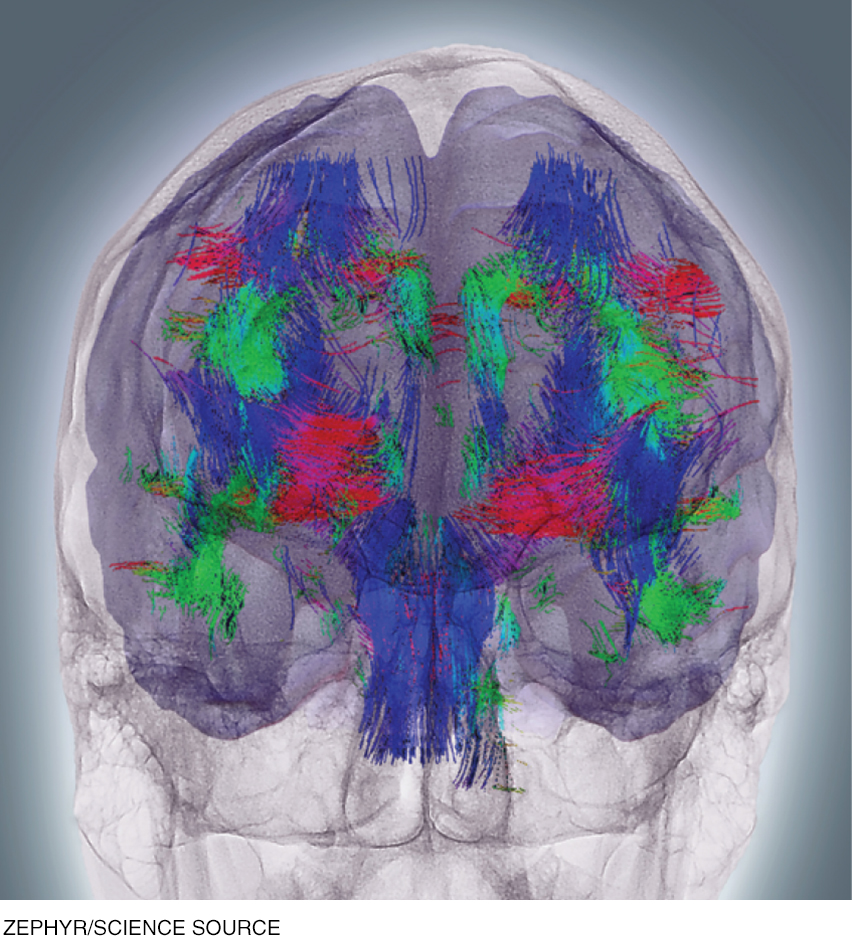Ongoing Features
Many characteristics of this book have been acclaimed since the first edition and have been retained in this revision.

Writing That Communicates the Excitement and Challenge of the Field
Writing about the science of human development should be lively, just as real people are. Each sentence conveys attitude as well as content. Chapter-
Coverage of Brain Research
Inclusion of neuroscience is a familiar feature of this book. Virtually every chapter includes a section on the brain, often enhanced with charts and photos to help students understand the brain’s inner workings. The following list highlights some of this material.
Epigenetics and brain function in depressed individuals, p. 7; illustrated (PET scans of brains of a depressed and a nondepressed person), p. 7
Neurological plasticity, pp. 21–
Prenatal growth of the brain, pp. 60–
Teratogenic effects on brain development, pp. 72–
Impact of anoxia on the brain, pp. 75–
A View from Science: the effects of pesticides and other chemicals on fetal brain development, p. 76
Consequences of low birthweight on brain development, p. 79
Brain development in the first two years, pp. 93–
Experience-
Dangers of shaken baby syndrome, p. 97
Parts of the brain in which hearing and language comprehension occur, p. 97
Brain abnormalities as possible cause of SIDS, p. 106
Consequences of stunting for brain growth, p. 111
Limitations of Piaget’s theory as revealed by brain scans, p. 117
Brain developments that support social emotions, pp. 132–
The effect of the stress hormone cortisol on the developing brain, p. 134
Opposing Perspectives: Genetic influences on temperament, especially the combination of DRD4 VNTR and 5-
Brain maturation and synchrony, pp. 137–
Brain development in early childhood (prefrontal cortex, myelination, lateralization, the limbic system), pp. 166–
Abnormal growth of the corpus callosum and ADHD, p. 171
Maturation of the brain and theory of mind, p. 180
The impact of toxic stress on the developing brain, p. 181
Neuroscience research on bilingualism, as well as its benefits, pp. 185–
The influence of myelination of the limbic system and growth of the prefrontal cortex in development of emotional regulation, pp. 203–
Development of the prefrontal cortex and rough-
Brain development and the development of empathy and antipathy, p. 219
Decreases in instrumental and reactive aggression as prefrontal cortex matures, p. 220
The effect of lead exposure on brain development, pp. 227–
The effects of physical exercise on the brain, p. 240
Formation of brain connections during middle childhood, p. 248
Neurological advances and selective attention, p. 249
Neuroscience confirming usefulness of information-
Development of control processes in middle childhood, p. 252
Brain development in middle childhood, pp. 253–
Research on how the brain works like a muscle, p. 268
Plasticity and specific learning disorders, p. 272
The effects of cumulative stress on brain function, p. 286
Brain abnormality as a possible factor in bullying, p. 303
The role of the pituitary gland in hormone production, pp. 316–
The role of the brain in regulating circadian rhythms, pp. 317–
Adolescent brain development; heightened arousal of reward areas of the brain, pp. 326–
Proportion of gray matter from childhood through adolescence, illustrated, p. 327
Benefits of adolescent brain development, p. 329
Dual processing as a result of brain maturation, pp. 333–
Role of 5-
Drug use and potential harm to the brain, pp. 379–
The impact of alcohol on the adolescent brain, p. 380
Physiological responses affecting neurological patterns, p. 392
Brain development and postformal thought, pp. 399–
Link between exercise and mental health, p. 429
Harmful effects of alcohol on the brain, p. 432
The aging brain and intelligence in adulthood, pp. 444–
The impact of stress on cognitive function, p. 447
Brain plasticity in adulthood, p. 461
Brain activity in musicians and non-
Cognitive reserve, p. 459
Expertise and the brain, p. 461
Personality and the brain, p. 469
Link between friendship and mental health, p. 477
Reactive attachment disorder among adopted children, p. 483
Psychological implications of unemployment and income disparity, p. 491
Genes, genetic clock, and life expectancy, pp. 512–
Cellular aging and telomeres, p. 513
Aging and the brain, pp. 520–
Information processing in late adulthood, pp. 522–
Brain diseases in late adulthood, pp. 525–
Benefits of brain plasticity and exercise in late adulthood, pp. 530–
Depression and other reversible conditions confused for neurocognitive disorders, pp. 532–
Intellectual abilities of older adults, pp. 534–
Religious involvement and depression in later life, p. 554
Mental capacity in late adulthood, p. 564
Major neurocognitive disorder and elder abuse, p. 567
Limbic system and prefrontal cortex affecting how children understand and cope with death, p. 576
Effects of drugs in palliative care, p. 584
End-
Coverage of Diversity

Cross-
New research on family structures, immigrants, bilingualism, and ethnic differences in health are among the many topics that illustrate human diversity. Listed here is a smattering of the discussions of culture and diversity in this new edition. Respect for human differences is evident throughout. You will note that examples and research findings from many parts of the world are included, not as add-
Inclusion of all kinds of people in the study of development, p. 4
Second-
Multi-
Culture defined; the need to include people of many cultures in developmental study, pp. 15–
Social constructions and cultural differences, p. 16
Concept of neurosexism as an example of difference-
Learning within a culture/cultural transmission (Vygotsky), pp. 17–
Race and ethnic group defined and discussed (includes Opposing Perspectives), pp. 18–
Age and regional differences in ethnicity across the United States (Visualizing Development), p. 20
Cultural and contextual influences on David’s life (A Case to Study), p. 22
Age diversity in cross-
Ethical dilemmas in the treatment of Ebola in West Africa, pp. 42–
Genetic variations among people: alleles, p. 48
Male and female sex chromosomes, pp. 51–
Opposing Perspectives: international differences in sex selection, pp. 52–
Prevalence of twins in certain cultures, p. 55
Birthing practices in various cultures, pp. 62–
Rates of cesarean births in selected countries, pp. 64–
Cultural differences in home births versus hospital births, pp. 66–
Incarceration of pregnant women who use alcohol and other psychoactive drugs, p. 75
Low birthweight and the immigrant paradox, p. 78
Rates of low birthweight in various countries, pp. 78–
Cultural differences in alcohol use and abuse, pp. 81–
Prevalence of nearsightedness in the United States and various Asian countries, pp. 82–
Opposing Perspectives: cultural differences in co-
Infant mortality rates in various countries, p. 104
Susan Beal and her research on SIDS, pp. 105–
Successes of immunization in various countries, p. 107
Breast-
A View from Science: changing trends in breast-
International rates of stunting, p. 111
Malnutrition: wasting in developing nations, pp. 111–
Cultural and family differences in infants’ exposure to language and language use, pp. 120–
Sociocultural explanation for language, p. 123
Cultural differences in emotions encouraged in toddlers, p. 131
The infant brain as a “cultural sponge,” pp. 132–
Genetic and gender differences in infant/toddler temperament, p. 136
Ugandan mothers’ contact-
Influence of SES on attachment type, p. 142
Outcomes for Romanian orphans adopted by North American, European, and Australian families, pp. 143–
Gender differences in parent–
Gender differences in child care, pp. 148–
Toddlers’ learning of gender roles according to social learning theory, p. 152
International comparisons of infant caregiving differences, pp. 154–
Parental leave policies in selected countries, p. 155
Changes in obesity rates in Brazil versus the United States, p. 165
Handedness and the difference-
Culture as a determinant of how one thinks and acts (social learning, Vygotsky), pp. 176–
Study of overimitation in South Africa, Botswana, and Australia, p. 178
Bilingualism in various nations; ethnicity and bilingualism in the United States; English proficiency among U.S. children whose home language is not English, pp. 185–
Cultural differences in parental preference for various preschool programs, pp. 192–
Effects of intervention programs on low-
Ethnic and SES differences in children’s activities, illustrated, p. 206
Cultural differences in young children’s play, pp. 208–
A View from Science: cultural differences in caregiving styles, p. 213
Sex and gender differences, pp. 213–
Cultural differences in child discipline, pp. 221–
Opposing Perspectives: cultural attitudes toward spanking, pp. 222–
Correlation between lead and crime in various countries, p. 228
Regional and ethnic differences in child maltreatment, p. 230
Cultural differences in recess time, p. 242
A View from Science: childhood obesity in the United States, by ethnicity; genetic propensity toward obesity and diabetes, pp. 242–
Childhood asthma and ethnicity in the United States, pp. 244–
International and sociocultural contexts in the role of instruction, pp. 249–
Cultural differences (Muslim children memorizing the Quran) in role of memory, p. 252
Cultural differences in metaphorical understanding, p. 255
Bilingual education, pp. 255–
International schooling and differences by nation, pp. 257–
Gender differences in school performance, p. 261
Ethnic and SES differences in academic performance, p. 262
Cultural considerations in IQ testing, p. 269
Consideration of children with special needs, pp. 270–
Cultural differences in self-
Children’s reactions to stress in Louisiana (Hurricane Katrina), Sri Lanka (tsunami), and Sierra Leone (war and child soldiers), pp. 286–
SES and resilience, p. 287
Family function within various structures, including families headed by same-
International rates of single-
Effects of SES on family structure and function, p. 299
Shyness and popularity in North America and China, p. 301
Gender differences in bullying, p. 303
Efforts to control bullying in various nations, p. 304
Gender differences in children’s retribution/restitution behavior, pp. 308–
Ethnic differences in timing of puberty, p. 320
Gender differences in reaction to early or late puberty, pp. 321–
Influence of body fat on onset of puberty (girls), p. 322
Nutritional deficiencies: U.S. ethnic examples, pp. 323–
Age differences in logical thinking, p. 337
Middle school engagement and dropout risk by SES and ethnicity, p. 342
Comparison of international scores on PISA, p. 346
Formation of religious, ethnic, political, and gender identity, pp. 353–
Ethnic prejudice and self-
Adolescent same-
Differences in sex education, U.S. and Europe, pp. 367–
Genetic and gender differences in risk of depression, pp. 369–
Gender differences in rates of teen parasuicide and suicide, pp. 371–
Adolescent rebellion as a social construction (international comparisons), p. 373
Ethnic differences in arrest statistics, p. 373
Gender differences in adolescent crime, p. 375
International comparisons: adolescent use of alcohol and cigarettes, p. 376
Differences in teen drug use by age, gender, and generation, pp. 376–
Secondary school attendance around the world and by gender, illustrated, p. 382
Cultural phenomenon of emerging adulthood, pp. 390–
Implications of acceptability of premarital sex for women, p. 394
The effect of globalization on the spread of infectious diseases, including STIs, p. 395
Sex differences in risk taking, illustrated, p. 396
Stereotype threat—
Gender gap in college education “paying off” for graduates, p. 403
Ethnic and gender differences in U.S. college enrollment, illustrated, p. 409
Exposure to diversity in college advances cognition, pp. 410–
Identity status changes in Sweden, p. 413
International differences in number of emerging adults living at home, p. 405
Gender differences in friendship, pp. 418–
Cultural differences in romantic relationships, pp. 419–
International differences in cohabitation, p. 422
Cultural and gender differences in smoking rates, pp. 430–
Cultural and gender differences in alcohol use, pp. 431–
International differences in adult obesity, pp. 432–
Gender differences in skin and hair appearance with age, p. 437
International and SES differences in disease and life expectancy, pp. 438–
Sex, fertility, and menopause in adulthood, pp. 440–
Age differences in intellectual abilities, pp. 445–
Impact of women’s education on reduction of disaster fatalities, p. 452
Stress and disasters around the world, pp. 453–
Gender differences in coping styles, p. 455
Concept of weathering in African American community, pp. 455–
Expertise and age, p. 461
Well-
International and gender differences in marriage rates, pp. 470–
International, cultural, and SES differences in marital happiness and divorce rates, pp. 471–
Gay and lesbian partners, pp. 474–
Gender differences in consequences of divorce, pp. 475–
Danish research on impact of family bonds, p. 478
Cultural differences in sibling relationships, p. 479
Gender differences in parental roles, pp. 481–
Nonbiological parents, pp. 482–
Cultural differences in caregiving, pp. 488–
Stress of unemployment in various nations, p. 491
Diversity in the workplace, pp. 492–
Immigrants in the workforce, p. 494
Impact of nonstandard work schedules on women of varying SES, p. 495
Finding the balance between work and life, pp. 496–
A Case to Study: explores whether women can have a family and a career, pp. 496–
Ageism and attitudes about aging, pp. 503–
Bicycle riding among elderly in several nations, p. 508
Demographic shift in the United States and other nations, pp. 508–
Results of severe calorie reduction in several countries, p. 512
Ethnic differences in genetic predisposition for type 2 diabetes, p. 513
Ethnic differences in telomere length, p. 513
Ethnic, SES, and religious differences in life expectancy, p. 514
Sexual activity in late adulthood, pp. 515–
Accommodations that could enable older adults to continue driving, p. 518
Gender and ethnic differences in rates of heart disease, p. 519
Prevalence of major NCD (dementia) around the world, p. 515; pp. 526–
Gender, ethnic, income, and age stratification, pp. 544–
Trends in volunteering around the world, p. 551
Aging in place, p. 552
Filial responsibility around the world, pp. 557–
Cultural differences in caring for the frail elderly, p. 562; pp. 565–
Religious and cultural differences in understanding and rituals relating to death, pp. 575–
Age differences in how people react to death, pp. 576–
International and cultural differences in rates of people receiving hospice and palliative care, pp. 582–
Cultural differences in acceptance of euthanasia, pp. 586–
Cultural and international differences regarding grief and mourning, pp. 592–

Up-to-Date Coverage
My mentors welcomed curiosity, creativity, and skepticism; as a result, I am eager to read and analyze thousands of articles and books on everything from the genes that predispose children to autism spectrum disorder to the complications of zygosity. The recent explosion of research in neuroscience and genetics has challenged me, once again, first to understand and then to explain many complex findings and speculative leaps. My students continue to ask questions and share their experiences, always providing new perspectives and concerns.
Topical Organization Within a Chronological Framework
The book’s basic organization remains unchanged. Two chapters begin the book with coverage of definitions, theories, genetics, and prenatal development. These chapters function not only as a developmental foundation but also as the structure for explaining the life-

The other six parts correspond to the major periods of development. With the exception of a lone chapter on prenatal development and birth, and another lone chapter on emerging adulthood, each age is discussed in two chapters, one for the biological and cognitive, and one for the social world. The topical organization within a chronological framework is a useful scaffold for students’ understanding of the interplay between age and domain.
Photographs, Tables, and Graphs That Are Integral to the Text
Students learn a great deal from this book’s illustrations because Worth Publishers encourages authors to choose the photographs, tables, and graphs and to write captions that extend the content. Observation Quizzes that accompany many of them inspire readers to look more closely at certain photographs, tables, and figures. The online Data Connections further this process by presenting numerous charts and tables that contain detailed data for further study.